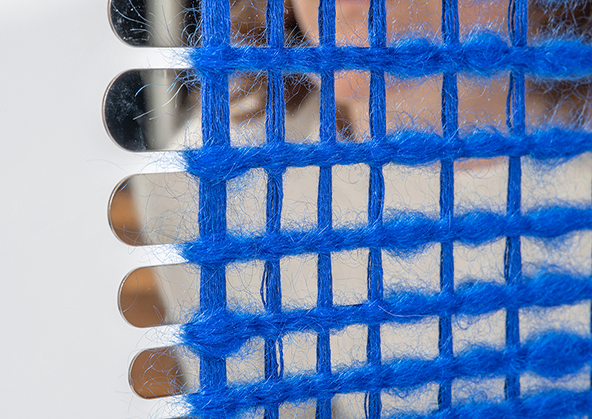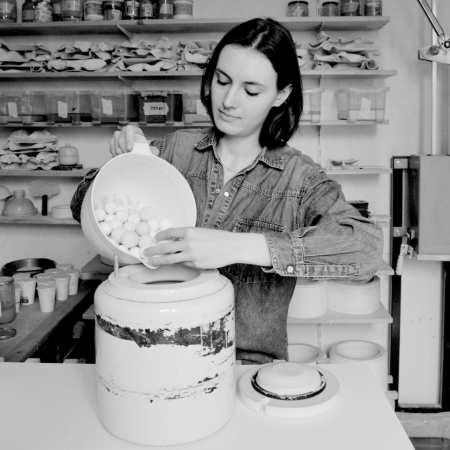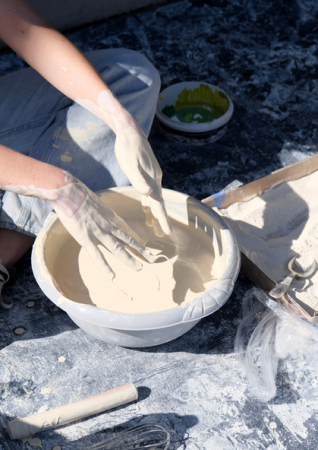
Luce Couillet, weaving as a plastic exploration of matter


Luce Couillet is a textile craftswoman and visual artist. In her studio, located at JAD since September 2023, she develops a contemporary conception of tapestry, using unconventional materials. Through her weaving practice, she gives life to hybrid sculptures, objects and graphic compositions, between textiles and marquetry.
On her arrival at JAD, Luce Couillet joined the Matière à penser artistic and cultural education program run by theAcadémie de Versailles in partnership with Les Grands Ateliers de France, the Musée des Arts Décoratifs and JAD, with the aim of raising awareness of weaving and its creative potential among pupils at Albert Camus secondary school in Brunoy. Luce Couillet is also committed to passing on her skills to young people, and is offering a workshop at the JAD during the Journées Européennes des Métiers d'Art to help them discover weaving and the workings of the material. Coordinated by theInstitut pour les Savoir-Faire Français, every spring the JEMA is an opportunity for the general public to discover the richness and diversity of arts and crafts and living heritage. For this 2024 edition, to be held from April 02 to 07, the spotlight will be on the young public, with the theme "Sur le bout des doigts" ("At your fingertips").
In this interview, Luce Couillet looks back at her career and her practice of weaving through her plastic sources of inspiration and her singular approach to material.
To begin with, could you tell us a little about your background and what led you to your current weaving practice?
My career path has been rather eclectic: I first trained in design at the Beaux-Arts de Reims, with a very plastic and quite experimental approach that quickly allowed me to dabble in everything. However, I felt that I lacked a more advanced technical tool on which to base my practical work, which led me to join the textile course atENSCI - Les Ateliers. This course, which was much more technical and complementary to the first, introduced me to weaving, knitting and braiding.
As soon as I graduated in 2010, I took the plunge and joined Les Ateliers de Paris in 2011. At the time, I was first working with textiles as a material, through my "Matières ouvertes" project: a material library of woven products designed for light filtration, sound insulation and acoustic insulation. In a form of low-tech R&D, I developed my own materials, collaborating with interior design, haute couture and the medical sector.
It was my interest in materials that guided me in this matériauthèque project. I've always believed that any material can be woven, such as recycled plastic. In my opinion, it's the unexpected associations of materials through weaving that give matter its sensitive and plastic values.
It was to continue this plastic exploration of matter that I gradually reoriented my practice, leaving R&D in favor of an approach to weaving more geared towards sculpture and the object.
Today, it's this approach to textiles as hybrid objects, as sculpture, that characterizes your work. Could you tell us more about this evolution in your visual language? What sources of inspiration guide the forms you create? How do you choose your materials?
After a while, I had this urge to create pieces that approached textiles not just as a material, but to give them a foothold, contours drawn, an inscription in space.
This new approach led me to turn to materials that were just as original, but more suited to the language of architecture, such as wire, wood, mirror, steel, felt and so on. Indeed, at the heart of my practice lies this desire to work with contrary materials, which weaving enables to assemble on an intimate scale, resulting in an object that becomes a kind of in-between.
In terms of form, I draw on different, sometimes contradictory sources of inspiration. I love the minimalism of primitive art, which inspires me with its somewhat schematic silhouette outlines. The optical art of Bridget Riley, Victor Vasarely and Julio Leparc also has a strong influence on my work, particularly in creating almost three-dimensional effects from 2D elements. Finally, I'm a great admirer of the work of choreographer Philippe Découflé and his costume designer Philippe Guillotel, which revolves around elastic, mysterious, slightly deformed bodies. I like to give the sculptures I create this hypnotic, spectacular yet offbeat aspect, which makes them hybrid objects, always in-between.
Let's talk about your collaboration with other craftspeople. How do these exchanges contribute to enriching your practice?
Working with materials that are not traditionally those of weaving, has led me to collaborate with other craftsmen and skills. For example, as part of a design project for the Gabonese Embassy in Libreville, I worked with materials such as paper, leather and steel, in collaboration with a cabinetmaker and a sheath maker. The intercultural dimension of this project also enabled me to enrich my plastic language, drawing inspiration from the geometric shapes and motifs of adouma masks and kota reliquaries from Gabon.
These collaborations are opportunities to open up new horizons and discover new techniques, new worlds. It's an approach I wanted to take further when I joined JAD a few months ago, to get away from the sometimes solitary practice of the craftsman and find a collective in which the exchange of ideas and creative emulation contribute to giving meaning to my work.
As part of the Matière à penser program, you teach middle-school students about weaving as a creative medium. How does this teaching experience influence your practice?
The Matière à penser program is a very enriching experience for me. It's an opportunity to step back and look at my own practice from a different angle. Indeed, working with these middle-school students has pushed me to simplify my approach and find fun, accessible ways of sharing my practice with them.
In a first workshop, we explored the founding principle of weaving by orthogonally crossing black and white strips of paper to create different patterns, on the same principle as computer code. Then, in a second workshop, we approached weaving from a more symbolic angle: we cut photographic portraits of the students into strips, which they then "wove" together, thus tackling the notion of hybridization and métissage. Next, we'll be working on a more volume-based approach to the material. Finally, in a final workshop, each student will be invited to create his or her own textile by sourcing various materials.
By offering young people the chance to explore their own creativity through weaving, this experience helps me to find meaning in what I do.
To conclude, what are your upcoming projects? What new creative fields has your presence at JAD opened up?
Over the past few months, several projects have been taking shape. I'd like to explore further the idea of creating less controlled, more organic pieces, using materials such as broken glass. This would be an interesting challenge for me, a way of leaving room for randomness and the beauty of the unexpected in my creative process. The collaborations I've initiated at JAD are also heading in this direction, whether weaving clay threads with ceramist and sculptor Anne Agbadou-Masson , or printing images on non-woven threads with gravure and intaglio printer Marie Levoyet. These projects promise to open up new creative perspectives through which I can continue to explore the frontiers of my plastic language, and I look forward to seeing them materialize.
Practical information
Matière à penser Artistic and Cultural Education program run by theAcadémie de Versailles in partnership with Les Grands Ateliers de France, the Musée des Arts Décoratifs and JAD
Journées Européennes des Métiers d'Art, April 02 to 07.
Program for the weekend of April 06 and 07 at JAD.
Textile sculpture workshop, Saturday April 06, 4pm-5.30pm for young audiences aged 6 and over. Free without reservation.
Interview by Brune Schlosser
In charge of cultural and heritage projects at INMA and INMA correspondent at JAD
On the same theme

Juana García-Pozuelo, rencontre entre l’idée et la main

Lucie Ponard, l'écologie des matériaux

Matière à Penser, un programme d'excellence dédié aux métiers d'art
